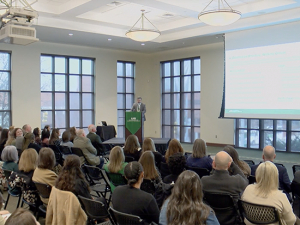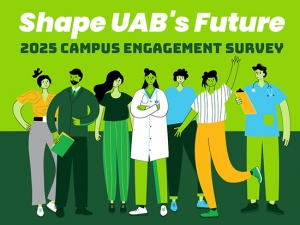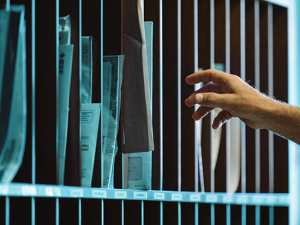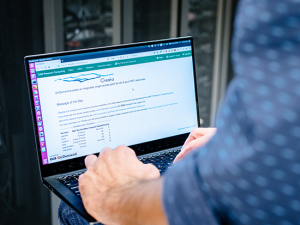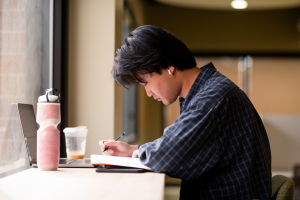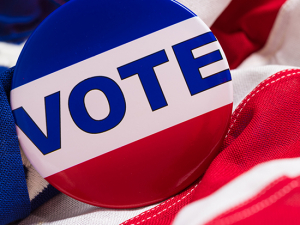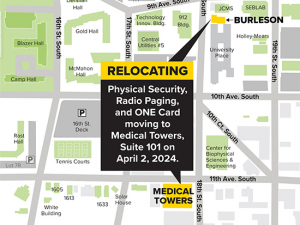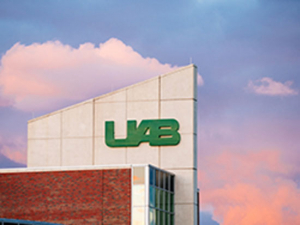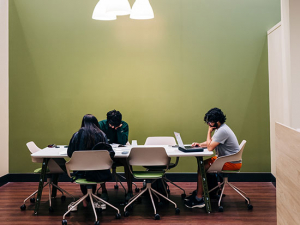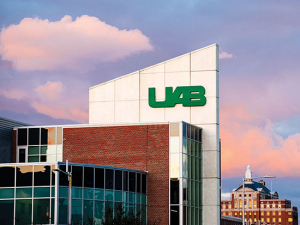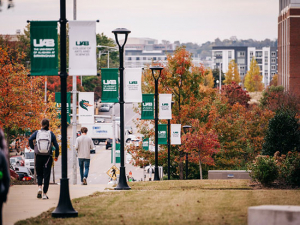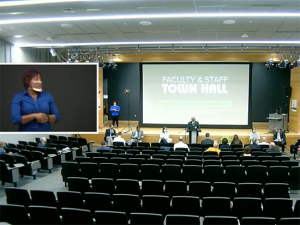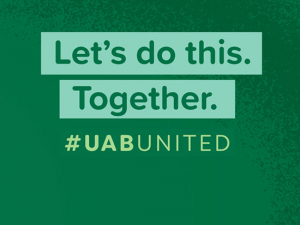 Senior leaders shared updates on planning for the re-entry to campus for Fall 2020 and answered faculty and instructor questions at a virtual town hall meeting on July 8.
Senior leaders shared updates on planning for the re-entry to campus for Fall 2020 and answered faculty and instructor questions at a virtual town hall meeting on July 8.
“The purpose of this town hall is for us to keep you as informed and updated as possible,” President Ray Watts said in his opening remarks. “The more you know about our detailed plans, the more you can have input.” Following an hour of discussion and questions, Watts concluded: “I hope that you see that everyone is planning for all contingencies. And there's a willingness to work with anyone around issues they might have. We want to be as flexible as possible and we want to maintain a high degree of safety.”
“I fully realize this is an incredibly stressful time and you are anxious,” Provost Pam Benoit said in her introductory comments. “I’m anxious as well. I know that many of you are trying to balance working and dealing with child care issues. You may have other family members that you have responsibilities for. This is a lot to try to deal with.
| This article summarizes the comments of UAB leaders and questions addressed during the live, hour-long town hall July 8. Answers to questions not addressed due to time constraints are provided in this sepearate piece. |
“At the same time, I have to thank you, because in the spring when we needed to pivot quickly, and even now through the planning process, it is very evident the faculty have been nimble, they have been creative, they have really been flexible about trying to help us to accomplish our mission,” Benoit said. “I am fully convinced that even under these extraordinary circumstances we have the will to provide a quality educational experience to our students. And I know for many of you that is why you got into this profession — trying to make sure we would help to increase knowledge in our own fields and disciplines.”
Throughout their remarks, Watts, Benoit and other leaders addressed questions and concerns raised by faculty in questions submitted prior to the town hall and live during the event. The article below summarizes these comments and answers provided during the town hall according to several broad categories. (A follow-up article next week on the Reporter site will provide answers to all questions that were unable to be answered live due to time constraints.)
Scroll down to read the complete summary or use the links below to jump to specific topics
Types of course delivery in Fall 2020
Classroom assignment planning process
Students with back-to-back in-person and remote classes
Technology resources for faculty
Technology resources for students
COVID precautions in the classroom
If a student or instructor becomes ill
Reporting symptoms to Employee Health: how it works
Course delivery
Types of course delivery in Fall 2020
“There are four different delivery methods that we have been talking about for the fall and the re-entry process,” Benoit said.
- Face-to-face
- Hybrid — a combination of in-person and remote instruction [read an FAQ on hybrid courses at UAB here]
- Remote
- Fully online courses
Fully online courses “are part of online programs, otherwise identified as ‘Q’ courses in the schedule,” Benoit said.
Classroom assignment planning process
“We are currently in the middle of a process of measuring all of the classrooms to see how we can socially distance students within those classrooms,” Benoit said. “About half of the schools have completed their work. We continue to work with another half of the schools. You may be in a different place from another department or another faculty member you are talking with because of the planning process that is involved in putting together the schedule.”
Question submitted online: The FAQs say that students can opt to switch from asynchronous to synchronous if they have back-to-back classes, but also that they will be assigned. How does this work?
Pam Benoit: “We're continuing to work through the process of assigning students into classes. Our thought was that we're trying to limit the number of students on campus on any given day and by letting students know for example that they are in cohort A and they'll be coming to campus on Monday and Tuesday that that will reduce the number of students on the campus and in the classrooms. And then the second cohort may come on Wednesday and Thursday or Thursday and Friday. So we're still continuing to work on that, as we identify with each of the schools how the courses will be taught that will give us a much better indication of what kinds of logistics issues we are working with.”
Faculty welcome bag
“In the fall we’re providing a bag that includes a number of items,” Benoit said. These include:
- Face shields (2) – “that you will want to wear in class so you can be heard and seen by the students and the cameras, and this will help you to record materials in the class,” Benoit said.
- Face masks (2) – to distribute to students who have forgotten to bring their masks to class as required.
The bags will also include a variety of other items so “you’ll have what you need to start,” Benoit said.
Students with back-to-back in-person and remote classes
Graduate School Dean Lori McMahon, Ph.D., who is chair of UAB's Campus Re-entry Implementation Team, noted that several faculty asked about timing of courses: students who are on campus for one class and remote in another class that same day without enough time to get home in between.
“I’m working with Greg Parsons, director of Facilities, to find spaces on our campus for students to go and socially distance and engage in a class through remote delivery,” McMahon said. An example of one of those spaces is Bartow Arena. IT is working on installing additional WiFi capability in Bartow so that students can go there and join a class through remote instruction, McMahon said. “We also think that students might use spaces like Bartow to study or listen to archived lectures. We’re thinking through all of these challenges that students may face when they are trying to engage remotely and also engage in person in classes.”
Question submitted through chat: What hours will the lots and Bartow be open, and what security will there be?
Answer from Curt Carver, Ph.D., vice president for Information Technology and Chief Information Officer: The hours for the parking lot are 8 AM to 10 PM. We have not [yet] coordinated the hours for Bartow Arena.
[back to topic list]
Classroom technology
Technology resources for faculty
Question submitted online: Who is responsible for uploading videos and recording videos in the classroom?
Pam Paustian, Ph.D., director of eLearning and Professional Studies: “Faculty will record their videos during the time that they are conducting their class. Those will automatically upload to the cloud that they have selected, whether that is the Kaltura Classroom or Zoom. And then they will go into their Canvas course and then the faculty member will have to go out and publish that recording so it is available for students.”
Question submitted online: If there's a malfunction with the video recording, who is responsible for that and when can we expect that it be resolved?
Pam Paustian: “AV technicians will be staged at appropriate locations based on classroom population. We will have roaming teams that will be there available with extra equipment for any type of hardware repair and if it is a software repair then we will elevate it to the vendor and our tiered support will help us to work through those issues. Our goal is to have the fewest number of defects possible through our testing.”
Question submitted online: If faculty do not know how to upload a recording, how do they learn to do that?
Pam Paustian: “The Division of eLearning will be offering a variety of training opportunities online and we also have that training archived on our website. And we'll provide step-by-step instructions at each of the podiums in each classroom.”
Question submitted online: Can we get an actual list of the technology that will be added to classrooms? For example, cameras, microphones, extra screen protectors? Will all classrooms have the same technology?
Curt Carver: “The classrooms will have different technologies based on their size. We're working with the Center for Teaching and Learning to have a demonstration room set up. That’s already done. So that the faculty can come look at the technology ahead of time. We need to publish a list of when each of the rooms are available. That has not been done yet, but we will. The intent is to have all of this deployed by Aug. 7, and to create that period between Aug. 7 and Aug. 24 where faculty can get very comfortable working with the Center for Teaching and Learning and the awesome folks in eLearning to be comfortable with the technology before the beginning of the semester.”
Scott Phillips, Ph.D., director of the Center for Teaching and Learning: “We're in the process of moving right now to the fourth floor of Lister Hill Library in the Edge of Chaos space. In August we'll begin hybrid workshops that model the technology and the teaching skills that faculty will be using when they are in class at the end of August. During the month of July all of our workshops will continue through Zoom and then in August there will be hybrid workshops where some faculty can attend in person and others will attend through Zoom.”
Question submitted by chat: So faculty will have to learn different technologies for different classrooms?
Answer from Curt Carver: The technology base is the same. There is a controller and a number of cameras based on the size of the classroom. All of this is integrated into the existing controller in the classroom as well as Canvas/Zoom/Kaltura. We are trying very hard to make this as easy as possible for the faculty member.
Question submitted online: What is the procedure to follow if we need software not currently available to implement the virtual aspects of the fall course offerings? Specifically I want access to a virtual whiteboard platform.
Pam Paustian: “Currently Zoom and Microsoft One Note, Microsoft Ink and Kaltura Capture all have whiteboard functions that can be used in that way. Also classrooms will be equipped with touch screen monitors supported by IT and/or document cameras that offer a similar function. If there is a need for a specific software that has not been previously used in the course, I would say to make the suggestion to IT and we can work to explore collaboratively with them to explore the options.”
Technology resources for students
Question submitted online: Where do we direct students if they do not have access to the required technology to fully participate in a Hyflex [hybrid] course? For example a lack of high-speed internet or webcam for proctored exams. Are there resources for these students?
Pam Benoit: Yes, we have several resources that we are putting together.
Curt Carver: “We have one remote parking lot open now and we're exploring three others right now where we would expand WiFi service into those parking lots so folks have connectivity. And we're working to engineer Bartow Arena, as Dr. McMahon said, for expanded WiFi activity and for students to go there and study safely.
“When this first broke out, we deployed a new app that established where there are WiFi locations around the state where students can use to gain access and we're working with the City of Birmingham and Jefferson County to expand that list to open parking lots and public libraries to look at expanding broadband across the state and I’m serving on a governor's task force with Dr. Eric Wallace from the School of Medicine to look at how CARES package funding can be deployed to expand internet access across the state.
“We've been working on this for several months and we are continuing to work on expanding access on campus and off campus for our students and we look forward to the students and faculty coming back and taking advantage of that. As new opportunities arise for us to expand that bandwidth we shall.”
John Jones, Ph.D., vice president for Student Affairs: “In the past four or five years, we have worked with an external agency to provide WiFi in the residence halls and with that we have over-capacity to continue to provide gaming and streaming as well as course work within the residence hall. Within the next couple of weeks we'll have an upgrade to our system as well. We'll have a higher grade and higher functioning in the residence hall that should not have any issues.”
Computer loan program
John Jones: “We also have a computer loan program. Student Affairs in partnership with Academic Affairs by way of Enrollment Management as well as IT, we have established a computer loaner program where we have several thousand laptop computers that will be made available to our students. Both undergraduate as well as graduate students. The minimum requirement is at least part-time, six hours of coursework for undergraduate students or five hours for graduate students. They have to be Pell-eligible or identify a need. So they submit an application, that application will be reviewed and upon approval, information will be shared with IT and then IT sends information to Dell and Dell will send the laptop directly to the student. Our goal is to get the computers in the hands of students prior to the start of the fall semester.”
Pam Benoit: “Another thing I’ll add. In the spring we became aware that we had students with computers, but without cameras on their computers. We also created a loaner program for cameras that were distributed to students as well. We have tried to think very hard about how do we make sure that students have access at this time.”
Curt Carver: “These computers that we're purchasing this time around will include cameras. It’s about 2,900 computers in the initial order. There may be more, based on CARES package funding and they do come with an integrated camera.”
Question submitted online: Some people may have very poor computer equipment at home, that is, their personal PC. Given that it seems like many will continue to work at home to a large degree for months, is there any plan to aid staff or other employees in purchasing better equipment at home on which to work, e.g. a discount or refurbishment program?
Curt Carver: “There is a component of the CARES package funding that we have not received approval on that provides funding for faculty machines. I’ll tell you that there are few loaners available on campus at this point because they've all been used locally by the departments.
“The technology store [TechConnect] does offer machines at a very steep discount. In fact, the best sales of the year that Dell offers, we're typically $50 to $100 less expensive than that.
“We're in the process of opening an Apple Store on campus probably by fall. We've delayed it because of the virus. There will be opportunities there. So, there are existing mechanisms right now to access computer equipment through the computer store.
“There are unfortunately no reserves of computers, those were exhausted quite a while ago. We do have a grant proposal in through CARES to have a loaner program for faculty as well as students. It's not been approved. When it is approved, we will share that.”
[back to topic list]
COVID precautions in the classroom
Question submitted online: How will classrooms be cleaned in between classes? Who is doing this?
Allen Bolton, senior vice president for Finance and Administration: “First, I will refer folks to the excellent reentry website where there is a whole section called UAB Facilities Re-entry Guidelines that gives a high-level overview of the extra cleaning protocols.
“There's going to be sanitizer, there's going to be a one-gallon bucket of hand wipes in each classroom. We're going to ask that there's a wipe-in, wipe-out procedure that students use for the surfaces they touch while in the classroom. The mask of course is a requirement during the time they are there. There will be cleaning of each classroom very thoroughly every night and we have a couple of misting machines that will be used to clean the classrooms in the evenings as well. That's a protocol that CDC has put out for the misting cleaning.
“During the day in common areas, corridors, stairwells and elevators, there will be masked environmental services personnel cleaning the commonly touched services very frequently throughout the day. A much higher level of cleaning protocol once the return happens.”
Question submitted online: Will PPE kits be available to adjunct professors and credentialed course instructors too?
Pam Benoit: “Anyone who is teaching in the fall will get one of the [welcome back] bags.”
Question submitted online: I am instructor of record for graduate classes in which several faculty teach. How do I go about ensuring we have sufficient face shields for all faculty who teach in my course?
Lori McMahon: “I’m thinking the question is related to courses that are team taught, there's only one instructor of record and that faculty member is on the list. Potentially the other instructors in a team-taught class, we may not know about those. So I can work with you and others to try to make sure that all instructors have what they need to teach.”
Enforcing mask wearing
Question submitted online: Who controls enforcement of in-class mask wearing? There will be students who will enter without a face covering or remove it during lecture. Is it up to the instructors to confront this?
Pam Benoit: “The first thing is, in this bag that I talked about earlier there will be a couple of disposable masks that you should take with you to class. So if a student forgot their mask or left it in the car, you can provide them with a disposable mask.
“The other issue is students who refuse to wear masks. If that happens and it's time for your class, just as you would with any other disruption, it's possible to cancel the class at that point and report that. We're particularly interested in individuals that repeatedly refuse to do that and then it goes to Student Conduct.”
John Jones: “Within Student Conduct, we have created a process that we want to be educational in regard to getting students to comply with all of the requirements that we're asking of them as they return to campus. And certainly we can be punitive if we need be. But as Dr. Benoit indicated, faculty members are responsible for classroom behavior. As certainly we as part of the Student Conduct, we will support that and can hold students accountable in the event they do not comply.”
Pam Benoit: “I’m working on putting material in your bags about how to have that conversation with the student. There's a lot of miscommunication out there about masks and whether or not they are effective. And I think having some of that information readily at hand could help you when you face these situations in your classrooms.”
John Jones: “I’ll add to please report that kind of behavior to our Student Conduct office. Even though the student may comply with your request, we need to know if the same individual is creating a pattern of being unresponsive in other classrooms as well. That will allow us to be more progressive in sanctioning.”
Pam Benoit: “I would also encourage you to add this information to your syllabus. It’s really important that you lay out the expectations of the classroom at the beginning of the class and reinforce that.”
Lori McMahon: “The text for the syllabus, we're working on that and we'll share it soon. The president of the Undergraduate Student Government and the president of the Graduate Student Government have been in conversations with leadership and these students are extremely passionate about wearing masks and social distancing. They are partners with us to help encourage students to follow the guidelines. We're excited about that and they have plans on how to communicate that and help peers hold one another accountable.”
Rosie O’Beirne, interim associate vice president for Digital Strategy and Marketing: “Hopefully people have started seeing that we have a campaign going called #UABUnited and it is emphasizing all of the safety practices we need to engage in to keep ourselves safe and others safe. Mask wearing is a key message of the campaign. Be on the lookout. We have fun social activities that we'll engage people in. I came to campus today and I’m starting to see new signage with the campaign going up in all of the buildings. ‘Mask up Blazers’ is the slogan and those signs will be visible to students coming in and out of buildings.”
 Post your #UABUnited selfie on social and make the campaign a part of your UAB email signature today.
Post your #UABUnited selfie on social and make the campaign a part of your UAB email signature today.If a student or instructor becomes ill
Question submitted online: Will in-person class instruction cease if a student tests positive for COVID-19 in that particular classroom? What happens if a student who attended a class in person tests positive for COVID?
Pam Benoit: “The first thing is there is a report, so we know there's a student who has tested positive. And the second is there will be an assessment if we have done the exposure notification about the amount of contact and how close that contact was with other people in that classroom. That is why we really hope that people will participate in the exposure notification application.”
Question submitted online: If a professor is sick, would you close the entire department? Would you track the students who were in their classes and students who also attended classes in that classroom? What would the procedure be?
Sarah Nafziger, M.D., medical director for Employee Health for UAB Medicine: “If we do have an employee or faculty member who tests positive for COVID-19, then the process is that we notify first, the employee directly. And that happens with a phone call with one of the physicians working in Employee Health. After we have that conversation with them, we follow up with an email notification to the employee and to their direct supervisor that has general information about COVID-19 and an estimated return to work date so you can plan for when you might be able to return to work.
“Part of the conversation that happens with the physician and employee is an extensive questioning, that is really where our contact tracing begins. Contact tracing is really all about conversations with people to find out who they've been in contact with. So, we’ll start gathering lists of names of people they've had high risk exposures too and that is defined as less than six feet apart for more than 15 minutes. So, we'll hand that information to contact tracers and they’ll begun working that information.
“You can’t really say there is going to be a global policy for a classroom to be shut down or a department closing down for any period of time. It’s really different in every scenario. And it’s based on the risk stratification of the specific exposures. We want to keep as many people here as we can and we want to do that safely.
“Rather than making broad statements we’re going to do this in a very focused manner which is very labor intensive to be honest, but that’s what we’re going to do.”
[back to topic list]
Faculty health accommodations
Question submitted online: What options do faculty have if they are part of a vulnerable population or live with someone who is part of a vulnerable population?
Pam Benoit: “The first thing is to have a discussion without revealing any health information with the chair to figure out what the options are within a department. In addition to that there is the AWARE program… also the possibility of leave if people feel that that would be a good option for them.”
Alesia Jones, Chief Human Resources Officer: “The AWARE program is the program that we have in place that helps with reasonable accommodations that are required for faculty and staff across the institution. So, we are definitely utilizing that program during this time of COVID. But as Dr. Benoit pointed out, what we are encouraging is that if there are reasonable accommodations that can be worked out outside of health conversations for health reasons, that happens between the chair and faculty member first. Because we believe that many of the accommodation requests can be worked out through those discussions. But if that's not the case and there are health-related reasons that accommodations are required, then the AWARE program is the place where we will manage that.”
“I saw a question about the confidentiality of AWARE program data. It is managed extremely confidentially. We do not share anyone’s health information with anyone else outside of the disability management process.”
Pam Benoit: “One of the reasons that the hybrid model is so attractive is that it is very flexible. I know that in a number of schools they are thinking about how they do a flipped classroom. Their lectures are done through video remotely and then they can meet in very small groups with students to reduce the number of people they come into contact with. Again, thinking about what are other reasonable accommodations and how we can use the hybrid model to accomplish that.”
[back to topic list]
Testing
Sentinel testing
Sentinel testing, which will involve random testing of roughly 2.5% of the on-campus employee population each week, started the week of July 6, said Anupam Agarwal, M.D., executive vice dean of the School of Medicine. Randomly selected employees will receive an email on Sunday nights, with the option of being tested at one of several UAB clinics on Tuesday through Thursday between 1 and 4 p.m. “We had about 50 employees tested yesterday and we’re waiting for the results today,” Agarwal said.
The goal is to identify if there are any clusters of positive cases “so we can take quick and prompt action,” Agarwal explained.
“We did a pilot run in mid-June of students and faculty and that went really well,” he said. The test uses a nasal swab, self-administered by the person being tested, with an observer making sure they did this correctly, he said. Agarwal and Medicine Dean Selwyn Vickers, M.D., both took part in pilot testing and “it’s very easy to be done by yourself,” Agarwal said. It is not nearly as intrusive as the nasopharyngeal swabs that many people are familiar with from images of COVID-19 testing.
Testing for Alabama
Experts from the Alabama Department of Public Health and UAB’s Division of Infectious Diseases have been leading the Testing for Alabama effort to provide testing for all 250,000-plus students in Alabama public higher education institutions, Agarwal said. There is a proposal to test “about 24,000 students in private higher education” institutions as well, he added.
These tests will occur 10 to 14 days before students arrive on campus for the fall semester.
Stay Safe Together
Sue Feldman, Ph.D., associate professor in the Department of Health Informatics in the School of Health Professions, shared an update on the Stay Safe Together platform.
Healthcheck
One tool in the Stay Safe Together platform is the mandatory Healthcheck, UAB’s COVID-19 assessment tool for all employees and students.
The first step in accessing Healthcheck is to take the COVID19: Basic Safety and Awareness Course training through UAB’s learning management system (LMS), Feldman said. (Human Resources sends a link to this training to employees who have been scheduled to return to campus by their supervisors.)
| This information is accurate as of publication. For the latest information on testing procedures and protocols, visit the uab.edu/coronavirus site here. |
When this training is complete, employees log in to Healthcheck using their BlazerID and answer questions about their current health. “If you have symptoms, you will see a popup screen asking you to confirm your symptoms — please be careful, because once you submit your symptoms if you have any, this cannot be undone,” Feldman said.
Question submitted online: For those of us who are 9-month employees, how long after we sign the consent do we have to report our symptoms at least every three days [through Healthcheck]? It would make sense for us to start reporting them beginning Aug. 15, our official return date, but the form is unclear as to when we are expected to begin reporting our symptoms regularly.
Alesia Jones, Chief Human Resources Officer: “Once you complete the process — as Sue mentioned, you go through the COVID awareness training and that leads you to Healthcheck, and you sign into the Healthcheck process. When you do that, that's when the three-day clock starts ticking and after that every three days you get a notification. You can do it daily, but you will at least get a reminder every three days.
“We've been trying, as close as possible, to send the notification for the training within two weeks of the time that we know people are scheduled to be back on campus. So, that gives you that two-week period to get the training complete and go through the Healthcheck process. If people do it sooner, then the Healthcheck process starts sooner.”
Pam Benoit: “It takes less than a minute to click on the responses to the questions. This is not an overly onerous task to ask you to do in order to continue to monitor how people are doing.”
Rosie O’Beirne: “Healthcheck is now available in the UAB app as well. It's a large button right when you open it. And it's also included in the myUAB portal. We're expanding the availability.”
Sue Feldman: “It's really best to do the Healthcheck every single day as a way to develop good habits around reporting your symptoms. Then you don't have to worry about the three-day reminder that you get.”
Question submitted by chat: Can the Healthcheck notification, and our response to it, every three days be sent via text messaging instead of e-mail? The outwardly facing version, HelpBeatCovid19, does it this way and it is much more convenient to respond to that.
Answer from Sue Feldman: Because Healthcheck is required, we cannot remind users only by text message as this requires users to submit a cell number. Since submitting a cell number is not required, we need a way to provide reminders to all users, regardless if they submit a cell number or not. This is the reason that the reminder is by email. However, if you do it every day, then there is no need for any reminder – email or text.
Exposure Notification App
This application is due out in a few weeks, Feldman said, and is being led by Brian Rivers and Curt Carver of UAB IT in coordination with the Alabama Department of Public Health.
Unlike Healthcheck, this is not a required application, Feldman noted. “Once you download the application [and enable Bluetooth], when you are within six feet of another person for greater than 15 minutes an encrypted, anonymous code is created,” Feldman explained. “Then later on if somebody tests positive for COVID-19 an anonymous message goes out.”
 The critical information for both Healthcheck and the Exposure Notification App is that “there is no tracking of anyone, anywhere, at any time,” Feldman said. “With the Exposure Notification App everything is anonymous and no personal information is collected.”
The critical information for both Healthcheck and the Exposure Notification App is that “there is no tracking of anyone, anywhere, at any time,” Feldman said. “With the Exposure Notification App everything is anonymous and no personal information is collected.”
“I know of only one other university in the entire United States that is using the combination that we are using of a symptom checking application and an exposure notification application to mitigate the spread of COVID-19,” Feldman said.
Question submitted through chat: So SST [Stay Safe Together] assumes that people have Bluetooth turned on, which I don't always do because it affects battery life. I need to keep it on while in public, evidently, to help this work.
Answer: The Stay Safe Together Exposure Notification app does require Bluetooth to be turned on. Additionally, it runs on low-energy Bluetooth, which is not the same as other apps that run in the background and drain your battery.
Employee COVID-19 testing
Testing results and trends
Sarah Nafziger, M.D., professor in the School of Medicine departments of Emergency Medicine and Neurology, and medical director for Employee Health for UAB Medicine, shared information on employee COVID-19 cases for the university and the health system.
Throughout the epidemic, as of July 8, UAB has cared for 611 COVID-positive patients, including 70 that were transferred to UAB Hospital from other hospitals, Nafziger said. There have been 94 total deaths at UAB Hospital attributable to COVID-19.
In January, the university and UAB Medicine partnered with the Occupational Health and Safety team, who normally manages employee health on the UAB campus, “so that UAB Medicine could support the campus as we faced the challenge of COVID-19… and we’ve continued to do so ever since,” including enhanced staffing capabilities in UAB Medicine Employee Health to support all UAB employees, Nafziger said.
“To date, we have had 356 total employees who have tested positive for COVID-19 and reported through Employee Health,” Nafziger said. Thirty-seven of those employees were UAB campus employees and of those cases about three-fourths were contracted in the community, with the remainder mainly due to employee-to-employee spread, she said.
For example, an employee might have shared a meal in a break room with another employee who was COVID-positive and that was the method of transmission, Nafziger said. In general for UAB Medicine employees, “early on in COVID we were seeing that employees were acquiring disease, some in the hospital. Since we implemented our safety and security measures the hospital acquired rate for employees has plummeted to nearly zero and most of the new cases we are seeing are due to community spread or employee to employee spread… Mostly people who are sharing a meal in a break room or who go out together after work and socialize. A lot of people have attended weddings together and we have had several clusters related to those types of events.
Currently, Employee Health is managing 88 active COVID cases in employees and we have another five new ones we have added so far today,” Nafziger said.
Reporting symptoms to Employee Health
The most important thing I can tell you today is that we are committed to being here for all of our employees – not just Medicine employees but campus employees, everyone across the board,” Nafziger said.
“We want you to report your symptoms and exposures to us and you do that through Healthcheck,” Nafziger said.
How it works:
- Employee notes symptoms on Healthcheck: “Once you complete the Healthcheck if you select you have a positive symptom it’s going to refer you to Employee Health and at that point we take over,” Nafziger explained.
- Employee Health is notified: “Your data comes into our system and we protect that as HIPAA-protected data. We take your privacy very seriously.”
- Employee is scheduled for testing: “We work with our test site to schedule your testing, which is expedited,” Nafziger said. “Typically it is next-day and we have results within a few hours. We manage your case throughout.”
- If COVID test is positive: “If you are COVID positive we will work with you and get referrals to our COVID Respiratory Clinic and make sure you are safe to return to work when that time comes,” Nafziger said.
[back to topic list]
International students
Question submitted online: Can you speak about the current challenges for our international students and are we expecting them to return to school in fall and will they be able to?
David Hofmann, executive director of INTO UAB: “The guidance that came out two days ago basically looks much like what guidance was prior to COVID coming into play in terms of the amount of online versus on-ground classes that students are able to take.”
The INTO UAB team is working with International Student and Scholar Services to develop an FAQ sheet to be made available to the campus community, Hofmann said. [Those FAQs are now online here.]
Students will fall into one of four broad categories, he noted:
- New students inside the U.S.
- New students outside the U.S.
- Continuing students inside the U.S.
- Continuing students outside the U.S.
“If they are in the U.S., they need to plan to come back to Birmingham, back to UAB, in order to take classes,” Hofmann said. “They will have opportunities to take an online class, but they will need to be in some face-to-face or hybrid related classes in fall to keep within status. If they are outside the U.S., we do have a lot more flexibility in what they can do in terms of taking only online classes.”
Dr. Benoit: “We learned this morning that MIT and Harvard have filed a lawsuit to create an injunction from this order going into effect. So we’ll continue to watch that as well.”
[back to topic list]
Research update
Christopher Brown, Ph.D., vice president for Research at UAB, shared details on the ongoing resumption of research activities on campus, which began on May 26.
Before being allowed to return to their labs, all research leaders (principal investigators) were required to develop an operational plan outlining how any work that needed to be done on campus would be accomplished while maintaining safe operations, including working in shifts, social distancing and wearing of face coverings. These plans must be approved by the department chair or division director and then the dean, Brown explained.
More than 500 operational plans have been approved, Brown said. That means roughly half of the university’s research faculty and staff “are able to be back on campus if their research requires they be on site.” There is a great deal of research activity that can be done without maintaining an on-campus presence, including writing grants and online mentoring, Brown said. “If is there no need to be on campus, then don’t.”
Brown encouraged employees to read the frequently asked questions on the Research site and to check back often as they are updated regularly in response to changing circumstances.
Funding growth
Despite the pandemic, UAB has continued to grow its research portfolio, Brown noted – improving on the record funding totals seen in fiscal year 2019. At the end of June new awards for sponsored activities were up 10%, or $38 million, relative to the same time last year. The number of submissions through the Office of Sponsored Programs are up as well, “showing that our faculty are taking advantage of this time to seek additional funding and also that our school and central administrators are working hard to get those grants and contracts processed,” Brown said.
Federal funding agencies have been extremely flexible in terms of requirements over the past few months and will continue to do so if they are able, Brown said. One important program is the RISE Act, a $26 billion funding package proposed through Congress to offset the costs related to lost research productivity. “We’ll keep a close eye on this and work to get the amount that we need to have,” Brown said. The FY2021 draft spending bill from the House Labor HHS Appropriations Subcommittee released this week contains increases for several funding agencies, including NIH, CDC and HRSA. “The funds are out there and we need to continue to pursue them,” Brown said.
[back to topic list]
